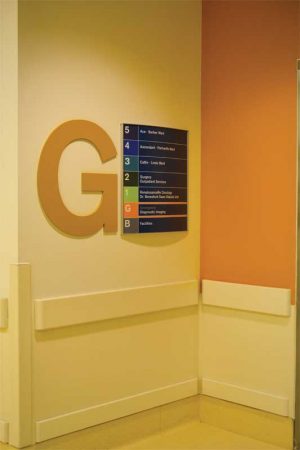The power of visual cues

Wayfinding systems should break down necessary navigational information into manageable and timely bits and provide users with this information at points along their journey where decisions must be made.
When planning a wayfinding system, there are three areas of impact relative to visual cues: first, special wall coverings (including super wall graphics) that might be specifically themed to the building’s brand or quickly display important information (i.e. a numeral to identify a parking deck level); next, the value of a handsomely displayed institutional information (e.g. a donor wall in a hospital) to draw attention to a specific location; and finally, a comprehensive directory—which, unlike the modest column-style reference points of the past, serves as a significant, eye-catching element of the wayfinding design.
So where do signs fit in? These communication tools are specifically important at the system’s decision points, beginning with the initial directory or map and proceeding from there. While landmarks and design play vital roles in establishing environment, a system’s signage is the ribbon that holds everything together by filling in any missing information. Signs provide users with the clarity, reassurance, and controlled messaging necessary to make navigational selections.
A decision point generally requires the person to make a choice: if a location leads to a frequently sought destination or is a point of reference for another location, it is considered a decision point. Signage is vital for these spaces, as it helps differentiate these navigational choices and provides users with the information needed to proceed. After all, the ultimate goal of a wayfinding system is to get the person to the desired destination and back again.
Thoughtful design
To paraphrase Italian designer Massimo Vignelli, design is not something to be taken lightly; rather, it creates a solution that must be subject.
Ultimately, signage must be user-focused. Understanding human behaviour and expectations, as well as the principles of good design, are key to successful wayfinding. In the process, the wayfinding experience is as much of an adventure for the designer and the signmaker as it is for the user.
Charles Kelly Jr. is the president of Clarke Systems. He can be reached via e-mail at ckellyjr@clarkesystems.com.





